

Alternative swine production systems and the hog welfare controversy
Now that you are familiar with the conventional hog production system used in the U.S., a system I refer to as a confinement-crate system, let us discuss two alternatives which some believe are more humane to the hogs. These are the confinement-pen and shelter-pasture system.
Confinement-pen system
In your virtual tour of the confinement-crate system you saw how pregnant sows are kept in crates so small the sow cannot turn around. She remains in this crate and on a hard, slatted floor, all day, every day, until she is ready to give birth, after which she is transferred to a farrowing-crate. Then, after her piglets are weaned she is moved back to the gestation-crate. A sow might spend two-thirds or more of her life in the gestation-crate.
It is this restrictive and barren crate that consumers and animal advocates particularly disapprove of, which is why bans on their use have been enacted in Florida, Arizona, Oregon, Colorado, California, Maine, Michigan, and Ohio.(N3) Can a farm maintain the confined production system without gestation crates? What does a conventional farmer do if she lives in a state where gestation-crates are suddenly banned? The answer is the confinement-pen system, which is virtually identical to the confinement-crate system except that instead of housing sows in individual crates, they are kept in groups.
Figure 1—Gestation-crates (left/top) and group-pens (right/bottom)
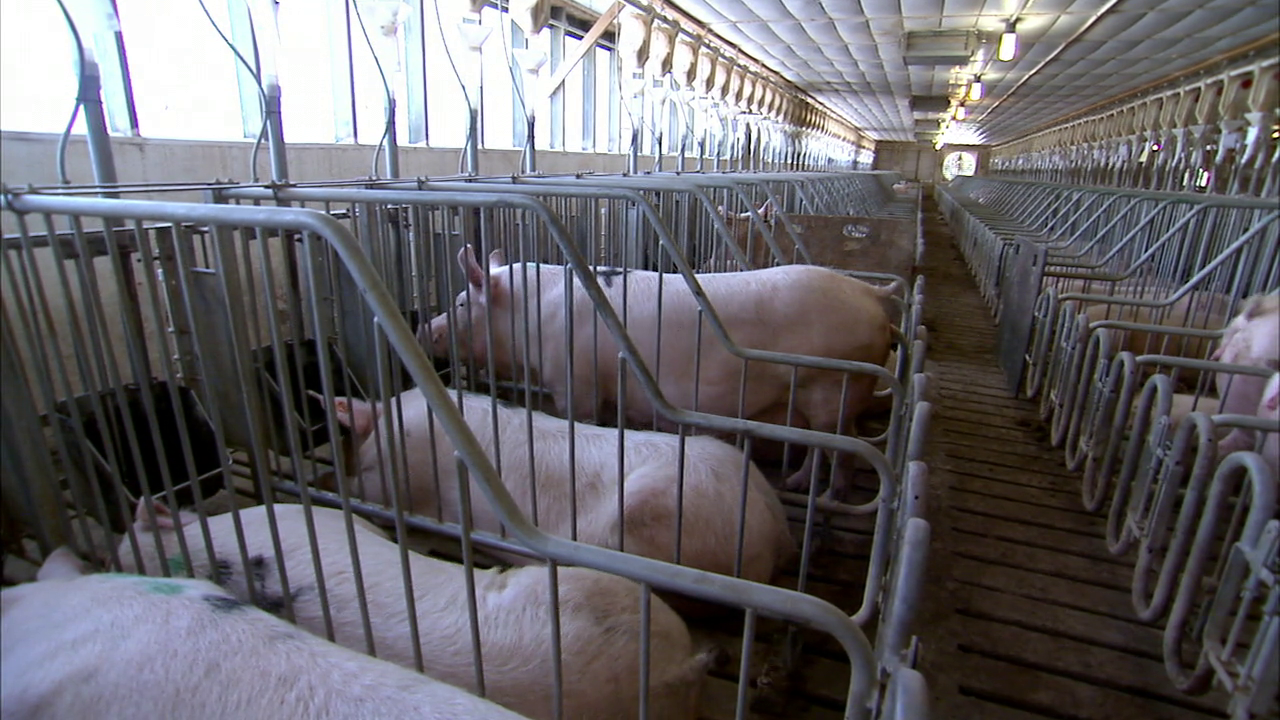

Group-pens are what the name implies: sows are placed in small groups of similar-size sows. No longer restricted by crates, sows are free to walk and turn around. They are also given more total space per sow. Each had about 14 square feet in the crate system but now have 16-24 square feet. With more room and mobility they can better find comfortable resting places.
There are some drawbacks to the group-pens. It is still a barren cage with no material to root in and no areas to explore. A hard, concrete floor rarely makes for a comfortable resting place. Sows are not always kind to one another, and out of boredom they may inflict injury upon one another. Moreover, if they are fed as a group the dominant sows may take food from more submissive ones, causing some sows to eat too little and others to eat too much. I know that some farms using group-pens use individual stalls where sows can enter and exit freely so they can eat alone, but I do not know the extent to which this practice used. Farms that do use such technologies will reduce the drawbacks of group-pens, so much so that group-pens might then be unambiguously better for the sows.
What do animal scientists say about the animal welfare of pregnant sows in crates versus group-pens? Because there are disadvantages to each, and because it depends on how the group-pens are designed, scientists are reticent to make blanket statements about one being better than the other. My research suggests that consumers definitely prefer the group-pens,(N2) but they are probably unaware of the extent to which sows may injure one another in groups.
The SOWEL (from “SOW” and “wELfare”) model evaluates two variates of the group-pen system, referred to as the ESF and the free-access system. Both systems not only use an open pen with more room but also technologies that limit aggression at feeding-time. The free-access allows sows to voluntarily enter and exit individual stalls for feeding, and the ESF uses an electronic feeding system, where instead of feeding all sows at once, they can only eat one-at-a time, in a protected area other sows cannot enter.
The SOWEL model finds that these alternatives are indeed superior in terms of animal welfare. This implies that the bans on gestation-crates in select states of the U.S. could improve the welfare of sows, assuming farmers find a way to limit competition between sows for food. If farmers fed all sows at once, as a group, then the SOWEL model results are not relevant and we must guess as to whether the sows are better-off. Because the nursery and finishing stages are identical in the confinement-crate and confinement-pen system, the only difference is in how the sows are treated. Thus, if the sows are better-off in the confinement-pen system, it is a better overall system (according to SOWEL) in terms of animal welfare. Let me stress that the previous sentence is not a “fact”. The SOWEL model is just one way of measuring welfare. The SOWEL model provides scientific judgments, not scientific facts.
Figure 2—Comparing confinement-crate to confinement-pen systems (higher score means happier sows)
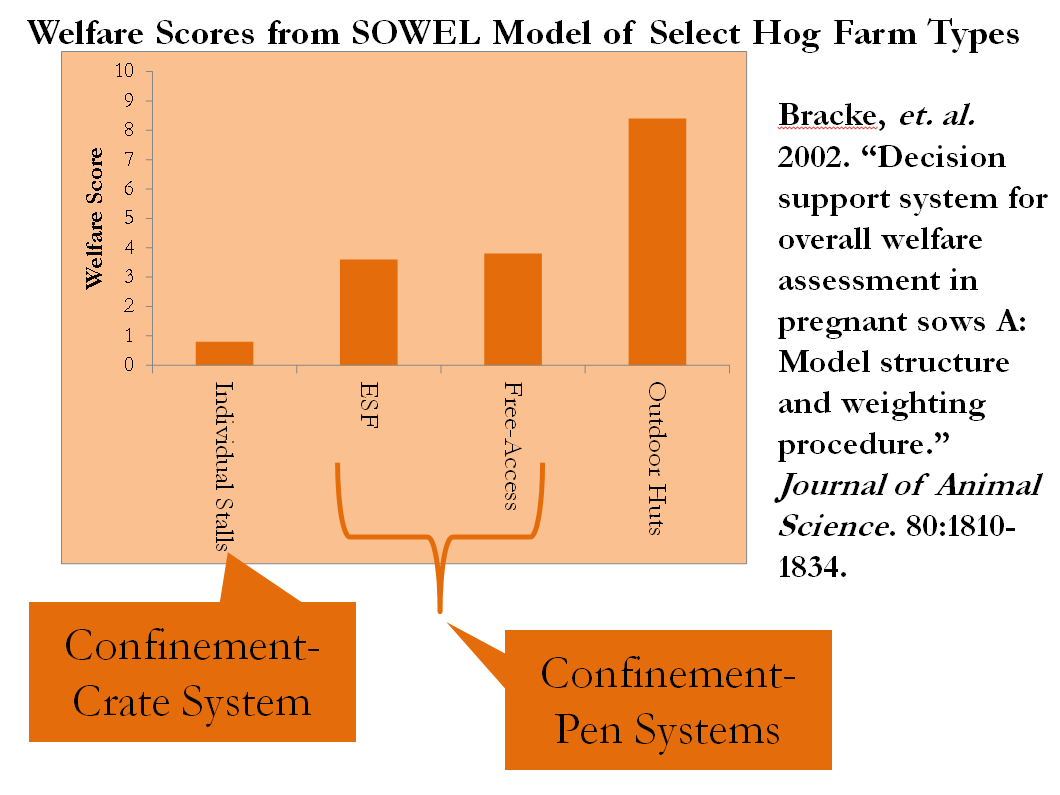
Shelter-pasture system
Some farmers have turned away from modern hog production technologies and embraced the farms of a century prior. In this system, hogs have frequent access to both shelter and pasture. They can dig, play in wallowing holes, explore, and do all the activities that they naturally crave to perform. During cold weather, they may be confined inside a barn, but with much more space per pig and constant access to bedding material, such as straw, mulch, or sawdust to dig in and create a comfortable resting space.
Figure 3—Farrowing hut in a shelter-pasture system
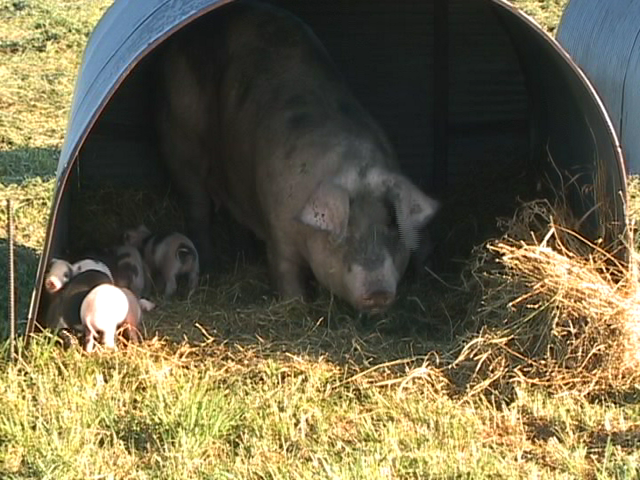
Figure 4—Outdoor access in a shelter-pasture system
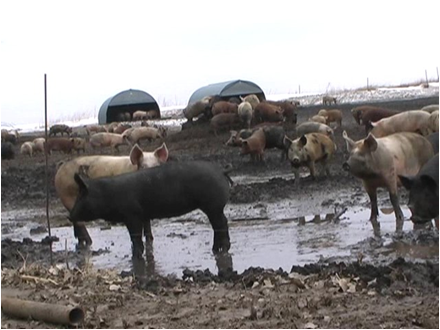
The sows give birth inside a private farrowing hut, which is a half-cylinder structure just tall enough for the sow to enter. Straw in the hut provides warmth and comfort (the straw is warm because its bottom layer is composting, which generates heat), and the sow and her piglets can leave and enter the hut freely. While it seems likely that the piglets will have a more pleasant life from the time of weaning till slaughter, the absence of a farrowing-crate means that more mothers will crush and/or neglect their offspring. Mortality rates of piglets will be higher than the confinement-crate system. Moreover, since the hogs have greater contact with other hogs and their feces, disease and parasites may be higher in the shelter-pasture system.
Because there is less boredom in the shelter-pasture system there is no need to dock the tails of the pigs, nor will there be much fighting among the sows. Piglets would not be weaned as early as they are in confinement systems, but would be allowed to nurse for up to six weeks.
Figure 5—Pasture access in a shelter-pasture system
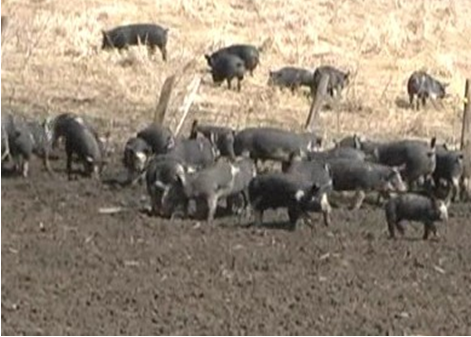
Overall, the SOWEL model ranks the shelter-pasture considerably higher than the confinement-crate or the confinement-pen system in terms of sow well-being. It says nothing about the piglets or those in the nursery or farrowing stage. It seems that if the sows are happier the pigs in the nursery and farrowing stage would as well, but it is less clear about the status of the piglets. Certainly, it is good that the piglets get to nurse longer and have more open areas to explore, but more of them will die from being crushed by their mother.
In the shelter-pasture system the SOWEL model only takes us so far, and we must rely on our personal judgment regarding the piglets.
Figure 6—Comparing confinement-crate, confinement-pen, and shelter-pasture systems (higher score means happier sows)
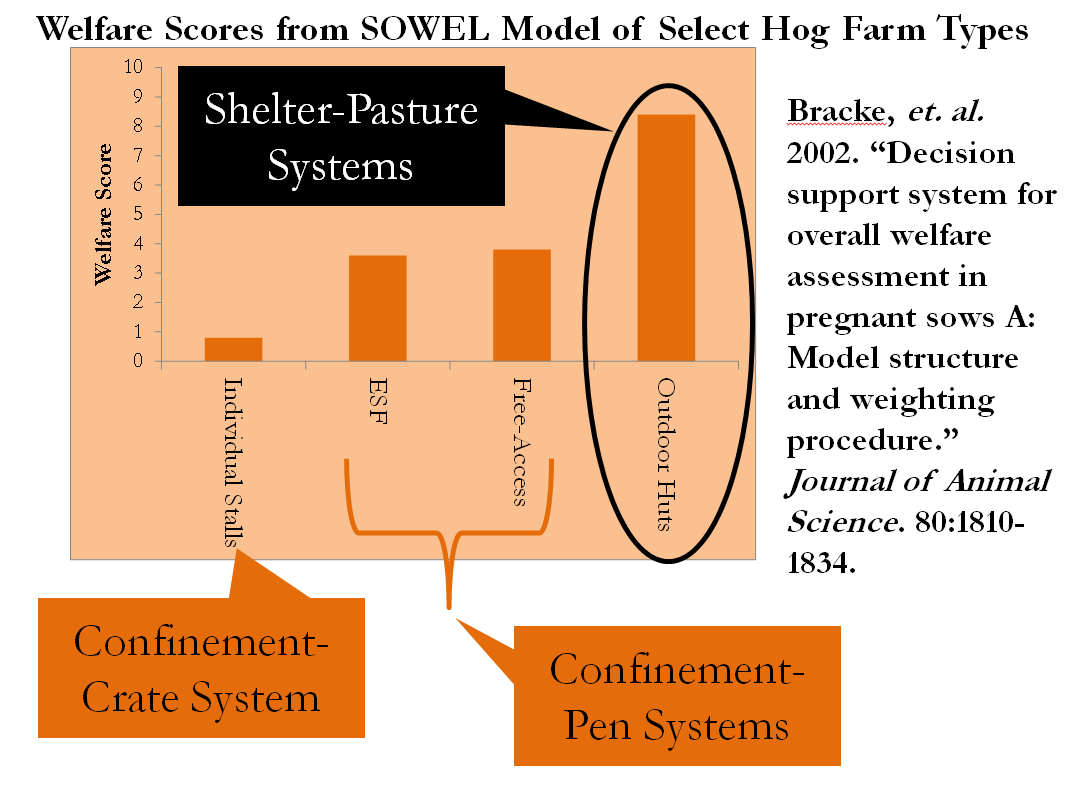
What is the price of happier hogs?
Suppose that you agree with the SOWEL model and decide that you would be willing to pay a premium for pork produced using a confinement-pen system, and an even higher premium for pork produced in a shelter-pasture system. How high might this premium be? This is not an easy question to answer.
Confinement-pen system
One of my former graduate students, Lacey Seibert, calculated the additional cost a farmer would incur if her gestation-crates were replaced with group-pens, thereby transitioning her farm from a confinement-crate to a confinement-pen system. Her research suggests that farm costs would increase by about $0.06 more per retail pound of pork. To help put this into perspective, the average retail price of pork is around $2.80 per lb, so this amounts to a 2% increase.(S1)
Will consumers pay $0.06 more for pork produced without gestation-crates? My colleague Jayson Lusk and I once visited the cities of Wilmington (NC), Chicago, and Dallas, and recruited people to participate in a consumer experiment. The individuals were first informed about the confinement-crate and the confinement-pen systems, and were then asked to bid on pork chops from these two systems in a real auction. If they won the pork chops, they actually had to pay for them using their own, real money. What we were trying to do was to mimic a shopping experience akin to a visit to a grocery store. We didn’t want to just ask them if they would pay $0.06 more; we wanted to see if they actually would, using real money.(N1)
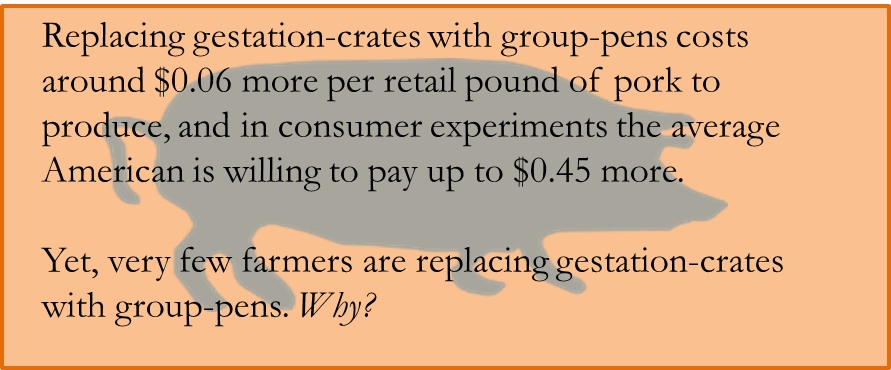
Their auction bids revealed that, yes, they would pay $0.06 more. In fact, the average individual was willing to pay $0.45 more! This suggests that although it does cost farmers money to replace gestation-crates with group-pens, the premium they could charge is much higher. It suggests that farmers would make more money with group-pens than gestation-crates.
The implication is that farmers would be stupid not to replace gestation-crates with group-pens, yet farmers mostly only do so when they are forced to by law, and farmers are anything but stupid. What is going on?
The answer is that, although the consumer experiments we conducted were scientifically sound, purchasing behavior in the experiment cannot be used to infer purchasing behavior in the grocery store. This is understood by the pork industry, and is why they do not use my experiments as part of their marketing strategy. In the experiments, we the researchers exposed individuals to information they would not see in the grocery store. By educating them about animal welfare we were implicitly encouraging them to consider animal welfare in their purchasing decision, again, something that doesn’t take place in grocery stores, or if it does, it happens at a more tempered level. Finally, people in an experiment know they are being watched and their behavior is observed, and that alone influences their behavior. When being observed, people tend to act more ethical, and this causes them to place more importance on animal welfare than they would in the grocery store.
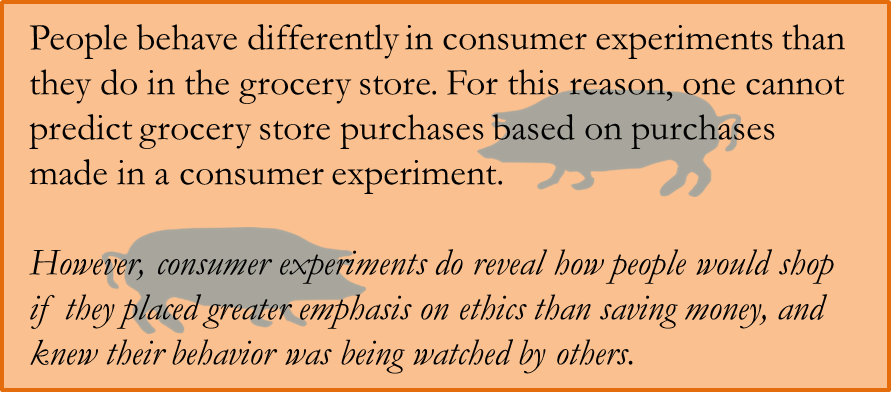
This doesn’t mean the experiments are not useful, as they do reflect real purchasing decisions made in a context where people place more emphasis on ethics than saving money. Experiments thus reveal how people would shop if they behaved more ethically and knew they were being watched, where what is “ethical” is determined both by personal beliefs and beliefs held by society. I should also add that the mere fact that I was conducting research in animal welfare might have implicitly communicated that I think we should improve animal welfare (regardless of whether that is the case). Research has shown that subjects do often behave in ways they believe the researcher approves. So even though I told them repeatedly that their bids should reflect their own, personal desires and beliefs, I also know that is hard for them to do. This tendency to behave in ways researchers and society approve of is referred to as social desirability bias, and is a major obstacle in conducting consumer surveys and experiments.(N1)
Shelter-pasture system
Pork from a shelter-pasture system is even more costly to produce: around $0.14 more per retail pound than the conventional confinement-crate system. This is probably a lower-bound, though, as it reflects the actual costs incurred by farmers currently using a shelter-pasture system. These farmers have more knowledge managing hogs in such a system, compared to farmers operating confined systems. If North Carolina farmers, the vast majority of which have only raised hogs in a confined system, converted to a shelter-pasture system, there would be a steep learning curve.
Shelter-pasture pork only costs around $0.14 per retail pound more to produce but in my experiments the average consumer would pay an astronomical premium of more than $3.00 per pound! It sounds absurd, I know. It is highly unlikely that anyone save for a few unique individuals would pay that much more for pork in the grocery store when the only thing that distinguishes it is that the hogs were raised more humanely. Again, the experiment participants knew they were being watched and probably felt like paying a high price for better animal care was the “socially desirable” thing to do.(N1,S1)
Actual pork prices
If we can only study consumer behavior in a grocery store by examining the behavior of their actual purchases in a grocery store, perhaps we can learn something from the actual grocery store prices for confinement-pen and shelter-pasture pork. Since prices must be between costs and consumers’ value (that is, consumers maximum willingness-to-pay), a price gives us a maximum for costs and a minimum for value.
It is difficult to find actual prices for pork produced on farms using a confinement-pen or shelter-pasture system, so instead I’ll refer to a pork product somewhere between the two. The Whole Foods grocery store uses a rating system established by the Global Animal Partnership to communicate the level of animal welfare in its food. During the December of 2013, I visited Whole Foods to purchase pork raised in what they call a “Step 1” system. Such farms use group-pens instead of gestation crates, but also provide other amenities like greater space allotments and bedding on 75% of the floor. The hogs are still raised indoors, but one with greater mobility and environmental enrichment.
It is almost certain that the SOWEL model would rate Step 1 as more animal-friendly than the conventional confinement-crate pork. Since the Step 1 system goes beyond the confinement-pen system but not as far as the shelter-pasture system, if the additional costs—and only those costs—at the farm were passed onto consumers we would expect the price of Step 1 ham at Whole Foods to be around 2% to 5% higher than pork raised in confinement-crate systems elsewhere, but the actual premium Whole Foods charges is much, much higher.
The ham I purchased at Whole Foods sold for $4.49 per lb, an enormous price compared to Food Pyramid (a conventional grocery store), which was selling ham (undoubtedly from a confinement-crate system) at the same time for only $1.69 per lb.
Figure 7—Label for Step 1 pork at Whole Foods

Figure 8—The price of Step 1 pork at Whole Foods in December of 2013

Figure 9—The price of confinement-crate pork at Food Pyramid in December of 2013

Why does Whole Foods charge so much? One reason might be: because they can. Perhaps Whole Foods shoppers are less sensitive to high prices than Food Pyramid? Or, perhaps consumers wanting animal-friendly foods will only believe animals are treated well if the price premium is large, in the same way that we are skeptical that a wine is truly a “fine wine” unless its price is high?
Another reason might be an inefficient distribution system. Most of the cost of food production occurs not at the farm but at the farm input sector and in the distribution of food. I doubt there is any company other than Walmart who can connect farmers with the rest of the country more efficiently than Food Pyramid. It probably costs Whole Foods much more to connect the few Step 1 producers with consumers from coast-to-coast, and that higher cost might be the main factor behind their high prices.
The future of hog production
It is unclear what hog production may look like twenty years from now. Although many states have indeed placed bans on gestation-crates, most of the major hog producing states are insulated against the voter initiatives and lobbyists hired by animal advocacy organizations.(S3) This suggests gestation-crates may still be used in twenty years.
On the other hand, gestation-crates are very unpopular with citizens, even if they still buy pork made from gestation-crates in the grocery stores. Animal advocacy organizations have learned they can pressure organizations like grocery store chains, fast food restaurants, and universities into agreeing not to purchase pork made with gestation crates.
Smithfield Foods is the largest pork producer in the U.S., and after feeling pressure to adopt group-pens and after studying such systems in Europe, they have already taken measures to convert some of the farms it owns to group-pens.(S2) While this conversion does not apply to the farms it contracts with (where most pork production takes place) this commitment to increasing the use of group-pens is a sign that in fifty years, gestation-crates may be a historical artifact. The word “may” is stressed.
What is the future? I must plead ignorance, but I do hope that this lecture has helped you better determine your own food preferences.
Figures
(1) Courtesy of the Oklahoma Pork Council.
(2) Original figure.
(3) Used with permission by an anonymous farmer.
(4-5) Personal photographs.
(6) Original figure.
(7-9) Personal photographs.